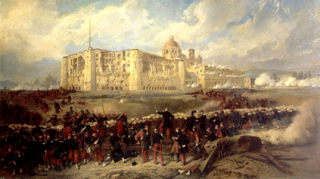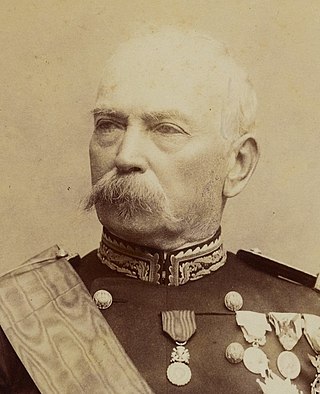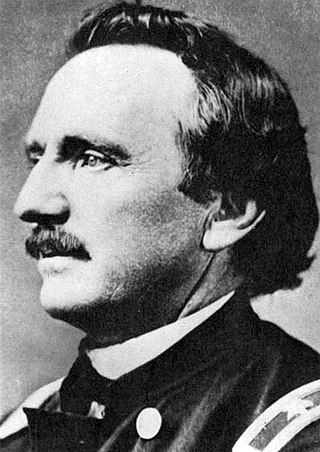
The 1860s was a decade of the Gregorian calendar that began on January 1, 1860 and ended on December 31, 1869.

The Battle of Puebla, also known as the Battle of May 5 took place on 5 May 1862, near Puebla de los Ángeles, during the second French intervention in Mexico. French troops under the command of Charles de Lorencez repeatedly failed to storm the forts of Loreto and Guadalupe situated on top of the hills overlooking the city of Puebla, and eventually retreated to Orizaba in order to await reinforcements. Lorencez was dismissed from his command, and French troops under Élie Frédéric Forey would eventually take the city, but the Mexican victory at Puebla against a better equipped force provided patriotic inspiration to the Mexicans.

The second French intervention in Mexico, also known as the Second Franco-Mexican War (1861–1867), was a military invasion of the Republic of Mexico by the French Empire of Napoleon III, purportedly to force the collection of Mexican debts in conjunction with Great Britain and Spain. Mexican conservatives supported the invasion, since they had been defeated by the liberal government of Benito Juárez in a three-year civil war. Defeated on the battlefield, conservatives sought the aid of France to effect regime change and establish a monarchy in Mexico, a plan that meshed with Napoleon III's plans to re-establish the presence of the French Empire in the Americas. Although the French invasion displaced Juárez's Republican government from the Mexican capital and the monarchy of Archduke Maximilian was established, the Second Mexican Empire collapsed within a few years. Material aid from the United States, whose four-year civil war ended in 1865, invigorated the Republican fight against the regime of Maximilian, and the 1866 decision of Napoleon III to withdraw military support for Maximilian's regime accelerated the monarchy's collapse.

Jean-Baptiste Billot was a French general and politician.

The Battle of Tacámbaro was a battle of the French Intervention in Mexico which took place on 11 April 1865 in the state of Michoacán in western Mexico. The battle, named after the town in which it was fought, pitted 300 members of the Belgian Legion supporting the Mexican Empire against approximately 3,000 Mexican republicans.
The 1st Kansas Infantry Regiment was an infantry regiment that served in the Union Army during the American Civil War. On August 10, 1861, at the Battle of Wilson's Creek, Missouri, the regiment suffered 106 soldiers killed in action or mortally wounded, one of the highest numbers of fatalities suffered by any Union infantry regiment in a single engagement during the American Civil War.
The Convention of London was a treaty, signed by France, Spain, and the United Kingdom, on 31 October 1861. The purpose of the treaty was to agree on a course of action towards obtaining loan repayments from Mexico. Although this went against the main tenet of the Monroe Doctrine, the United States was not in a position to offer much opposition as it was engulfed in its own civil war.

The 1st Regiment California Cavalry was a cavalry regiment in the Union Army during the American Civil War. First formed as a battalion, the unit later expanded to regimental size.

Coronango is a town and municipality in the Mexican state of Puebla in south-eastern Mexico.
Fort Cummings is a former U. S. Army post located near Cooke's Springs, in Luna County, New Mexico. It is located 20 miles northeast of Deming, New Mexico.

The Commemorative medal of the Mexico Expedition was a French commemorative campaign medal established by decree of French Emperor Napoleon III on 29 August 1863 to recognize military service during the 1862-1863 French intervention in Mexico.

William Franklin Raynolds was an American explorer, engineer and U.S. army officer who served in the Mexican–American War and American Civil War. He is best known for leading the 1859–60 Raynolds Expedition while serving as a member of the U.S. Army Corps of Topographical Engineers.

The Battle of Acapulco were a series of battles during the Second French intervention in Mexico. Acapulco was a key port of the Pacific trade routes and thus changed hands several times in the course of the Franco-Mexican war. In this period the population of the city had decreased from 6000 to 2000.

The Battle of San Pedro was fought between the French and Mexican imperial forces and the Mexican Republicans during the Second French intervention in Mexico on 22 December 1864. The liberals achieved a decisive victory over the invading forces and captured the majority of the survivors.

The Battle of Barranca Seca was a battle of the Second French intervention in Mexico and took place right after the Battle of Puebla on 18 May 1862. Contrary to the latter it was won by the unified reactionist Mexican-French forces. The battle was preceded by a coup de chef of the reactionist forces, which was heated by the intrigue of the Spanish high command against Almonte and Márquez and French pressure towards the replacement of Zuloaga. After the battle Almonte remained the only contender for the Commander-in-Chief office within the reactionist party and Márquez as acting General; both of them serving French interests.

The Battle of San Juan Bautista was a battle in the Second French intervention in Mexico fought on February 27, 1864. Mexican Republicans were victorious and retook control of the city. The Republican forces consisted only of the Tabasquian militia from the surrounding areas ranging between 300 and 1,100 men, only half of whom were equipped with firearms the others fought with machetes.
The Department of the Northwest was an U.S. Army Department created on September 6, 1862, to put down the Sioux uprising in Minnesota. Major General John Pope was made commander of the Department. At the end of the Civil War the Department was redesignated the Department of Dakota.

The siege of Puebla occurred between 16 March and 17 May 1863 during the Second French intervention in Mexico, between forces of the Second French Empire and forces of the Second Federal Republic of Mexico. The French were advancing toward Mexico City, and were blocked by Mexican troops at Puebla.

Henry Erastus Noyes was a United States Army Officer who served during the American Civil War, American Indian Wars and Spanish–American War.

Battery E, 1st Missouri Light Artillery Regiment was an artillery battery unit from Missouri that served in the Union Army during the American Civil War. The 1st Missouri Light Artillery Regiment formed on 1 September 1861. The battery participated in Frémont's expedition to Springfield in October 1861. This was followed by actions at Prairie Grove and Van Buren in December 1862. The following year, the battery fought at Cape Girardeau, Chalk Bluff, Vicksburg, the Expedition to Morganza, Brownsville, and Fort Esperanza. After performing garrison duty at Brownsville, Texas, the unit was mustered out in June 1864. For a few months at the end of 1864, a Pennsylvania battery took the name of this unit.
















